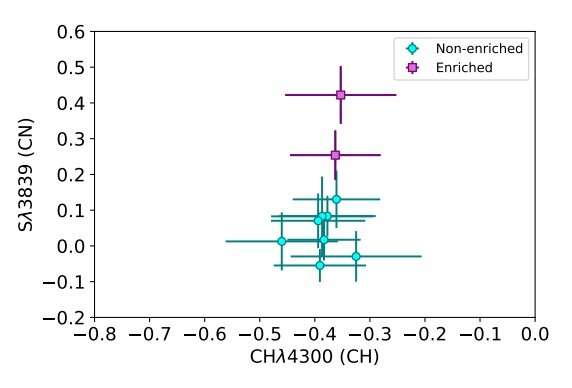February 18, 2019 report
Multiple stellar populations detected in the cluster Hodge 6

Using ESO's Very Large Telescope (VLT), astronomers have found that the cluster Hodge 6 hosts multiple stellar populations. The detection could provide important hints on the formation and evolution of Hodge 6 and star clusters in general. The finding is detailed in a paper published February 7 on arXiv.org.
Observations show that almost all globular clusters (GCs) exhibit star-to-star abundance variations of light elements such as helium (He), oxygen (O), nitrogen (N), carbon (C) and calcium (Na). This indicates self-enrichment in GCs and suggests that star clusters are comprised of at least two stellar populations.
Recent studies have found that multiple stellar populations are also present outside GCs, including intermediate age massive star clusters (between 2 and 8 billion years old). With an age of about 2 billion years, Hodge 6, located in the Large Magellanic Cloud (LMC), is an example of such cluster. A team of astronomers led by Kathie Hollyhead of Stockholm University, Sweden, now reports that Hodge 6 also hosts at least two populations of stars.
The astronomers employed VLT's FORS2 instrument to conduct spectroscopic analysis of Hodge 6. They obtained low-resolution spectroscopy of lower red giant branch (RGB) stars in the cluster in order to look for signatures of multiple populations in CN and CH band strengths that trace nitrogen and carbon.
"We report the spectroscopic discovery of abundance spreads (i.e. multiple populations) in the ≈2 Gyr old cluster in the LMC, Hodge 6. We used low-resolution VLT FORS2 spectra of 15 member stars in the cluster to measure their CN and CH band strengths at ~3883 and 4300 ̊A, respectively, as well as [C/Fe] and [N/Fe] abundances," the researchers wrote in the paper.
FORS2 spectra allowed the team to detect a sub-population of two stars enriched in nitrogen, which, according to the study, is indicative of multiple populations in Hodge 6. The researchers add that these stars showcase spread in CN, which traces nitrogen, with negligible spread in CH, which traces carbon.
Furthermore, given that Hodge 6 exhibits no extended main-sequence turn-offs (eMSTOs), features commonly found in the color-magnitude diagrams of young and intermediate-age massive star clusters, the scientists suspect a possible correlation between this phenomenon and the presence of multiple populations. However, more studies are needed in order to determine whether these two phenomena are related.
"The apparent coincidence of the lack of eMSTOs and the beginning of MPs [multiple populations] could well be just that—a coincidence. Relatively few clusters have been studied at this exact age limit, so there is not a statistical consensus to indicate that these two phenomena are related, though studies so far do point to an age dependence on the onset of MPs," the paper reads.
The researchers note that Hodge 6 turns out to be the second cluster with an age of around 2 billion years and that hosts multiple populations, after NGC 1978 in LMC. Their study also marks the first spectroscopic detection of multiple populations in a cluster of this age.
More information: arxiv.org/pdf/1902.02297.pdf
© 2019 Science X Network





















